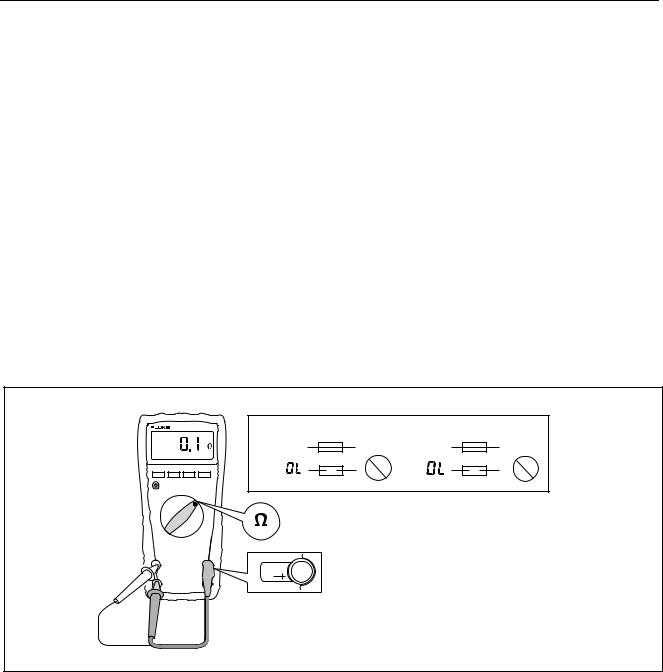Fluke 175, 177, 179 RMS User Manual

175, 177, & 179
True RMS Multimeters
Calibration Information
Introduction
XWWarning
To avoid electric shock or injury, do not perform the performance tests or calibration adjustment procedures unless qualified to do so.
The information provided in this document is for the use of qualified personnel only.
The 175, 177, & 179 Calibration Information provides the information necessary to adjust and verify the performance of the Fluke Models 175, 177, and 179 True RMS Multimeters (hereafter known as the Meter).
The following information is included in this document:
•Safety Information and International Electrical Symbols
•Test Lead Alert
•Specifications
•Testing and Replacing the Fuses
•Replacing the Battery
•Cleaning
•Replacing the LCD
•Performance Tests
•Calibration Adjustment
•User-Replaceable Parts and Accessories
•Complete Warranty
See the 175, 177, & 179 Users Manual for complete operating instructions.
Service Information
To contact Fluke, call one of the following telephone numbers:
USA: 1-888-99-FLUKE (1-888-993-5853)
Canada: 1-800-36-FLUKE (1-800-363-5853)
Europe: +31 402-675-200
Japan: +81-3-3434-0181
Singapore: +65-738-5655
Anywhere in the world: +1-425-446-5500
Or visit Fluke's Web site at: www.fluke.com.
To register your product, visit http://register.fluke.com
PN 1600476 March 2001 Rev.5, 2/08
© 2001-2008 Fluke Corporation. All rights reserved. Product specifications are subject to change without notice. Printed in U.S.A.
1

175, 177, & 179
Calibration Information
Safety Information
"Warning" and "Caution" Statements
A “XW Warning" identifies hazardous conditions and actions that could cause bodily harm or death.
A "W Caution" identifies conditions and actions that could damage the Meter, the equipment under test, or cause permanent loss of data.
XWWarnings and Precautions
To avoid possible electric shock or personal injury, and to avoid possible damage to the Meter or to the equipment under test, adhere to the following practices:
•Use this meter only as specified in this manual or the protection provided by the Meter might be impaired.
•Before using the Meter, inspect the case. Do not use the Meter if it is damaged. Look for cracks or missing plastic. Pay particular attention to the insulation around the connectors.
•Inspect the test leads for damaged insulation or exposed metal. Check the test leads for continuity. Replace damaged test leads before using the Meter.
•Verify the Meter’s operation by measuring a known voltage. Do not use the Meter if it operates abnormally. Protection may be impaired. When in doubt, have the Meter serviced.
•Do not apply more than the rated voltage, as marked on the Meter, between the terminals or between any terminal and earth ground.
•Use caution when working with voltages above 30 V ac rms, 42 V ac peak, or 60 V dc. These voltages pose a shock hazard.
•Use the proper terminals, function, and range for your measurements.
•Do not operate the Meter around explosive gas, vapor, or dust.
•When using the probes, keep fingers behind the finger guards.
•When making connections, connect the common test lead before connecting the live test lead; when disconnecting, disconnect the live test lead before disconnecting the common test lead.
•Disconnect circuit power and discharge all high-voltage capacitors before testing resistance, continuity, diodes, or capacitance.
•Before measuring current, check the Meter's fuses (see "Testing the Fuses") and turn OFF power to the circuit before connecting the Meter to the circuit.
•Do not operate the Meter with the case (or part of the case) removed.
•Use only a single 9 V battery, properly installed in the Meter case, to power the Meter.
•Replace the battery as soon as the low battery indicator (b) appears. With a low battery, the Meter might produce false readings that can lead to electric shock and personal injury.
•Remove test leads from the Meter before opening the Meter case.
•When servicing the Meter, use only specified replacement parts.
•When replacing the fuses, use ONLY Fluke-specified fuses as listed in Table 5.
2

True RMS Multimeters
International Electrical Symbols
International Electrical Symbols
The following international symbols appear in this document and on the Meter.
B |
AC (Alternating Current) |
J |
Earth ground |
|
F |
DC (Direct Current) |
I |
Fuse |
|
F |
AC or DC |
P |
Conforms to European Union directives |
|
B |
||||
|
|
|
|
|
W |
Risk of danger. Important Information. |
$ |
Conforms to relevant Canadian Standards |
|
Refer to the manual. |
Association directives |
|||
|
|
|
|
|
X |
Hazardous Voltage |
T |
Double insulated |
|
s |
Technischer Überwachungs Verein. |
! |
Underwriters Laboratories, Inc. |
|
German certifying body. |
Meter in accordance with IEC 61010-1. 54CJ |
|||
|
|
|
||
|
|
|
|
|
b |
Battery. Low Battery when shown on |
; |
Conforms to relevant Australian standards |
|
display. |
||||
|
||||
|
|
|
Do not dispose of this product as unsorted |
|
# |
Verband Deutscher Electroniker. German |
~ |
||
municipal waste. Go to Fluke’s website for |
||||
electronics association. |
||||
|
|
|
recycling information. |
Test Lead Alert
XWWarning
Personal injury or damage to the Meter can occur if the user attempts to make a measurement with a lead in an incorrect terminal.
As a reminder to check that the test leads are in the correct terminals, LEAd is displayed when the Rotary Switch is moved to or from the mA or A position.
3

175, 177, & 179
Calibration Information
Specifications
Accuracy is specified for 1 year after calibration, at operating temperatures of 18 °C to 28 °C, with relative humidity at 0 % to 90 %. Accuracy specifications take the form of: ±( [ % of Reading ] + [ Counts ] ). AC conversions are ac-coupled, true rms responding.
Maximum voltage between
any terminal and earth ground: 1000 V dc or ac rms
Surge Protection: |
8 kV peak per IEC 61010 |
WFuse for mA inputs: 440 mA, 1000 V FAST Fuse, minimum interrupt rating 10 kA
WFuse for A input: 11 A, 1000 V FAST Fuse, minimum interrupt rating 17 kA
Display: |
Digital: 6000 counts, updates 4/sec |
|
Bar Graph: 33 segments; |
|
Updates 40/sec |
|
Frequency: 10,000 counts |
|
Capacitance: 1,000 counts |
Altitude: |
Operating: 2000 m; Storage: 12,000 m |
Temperature: |
Operating: -10 °C to +50 °C; |
|
Storage: -40 °C to +60 °C |
Temperature coefficient: |
0.1 X (specified accuracy) / °C |
|
(<18 °C or >28 °C) |
Electromagnetic Compatibility |
In an RF field of 3 V/M, accuracy = specified accuracy except in temperature: |
(EN 61326-1:1997): |
specified accuracy ±5 °C (9 °F) |
Relative Humidity: |
Maximum, Noncondensing |
|
90 % to 35 °C |
|
75 % to 40 °C |
|
45 % to 50 °C |
Battery Life: |
Alkaline: 400 hrs typical |
Size (H x W x L): |
4.3 cm x 9 cm x 18.5 cm |
Weight: |
420 g |
Safety Compliances: |
ANSI/ISA S82.02.01, CSA C22.2-1010.1, IEC 61010 to 1000 V Measurement |
|
Category III, 600 V Measurement Category IV |
|
CAT IIIEquipment designed to protect against transients in equipment in fixed- |
|
equipment installations, such as distribution panels, feeders and short branch circuits, |
|
and lighting systems in large buildings. |
|
CAT IVEquipment designed to protect user against transients from the primary |
|
supply level, such as an electricity meter or an overhead or underground utility |
|
service. |
Certifications: |
CSA, TÜV (EN61010), P, ;(N10140), VDE, UL |
4
|
|
|
|
|
|
|
|
True RMS Multimeters |
|
|
|
|
|
|
|
|
|
|
|
Specifications |
|
|
|
|
|
|
|
|
|
|
|
|
|
|
|
|
|
|
|
|
|
|
|
|
|
Function |
Range 1 |
Resolution |
Accuracy ± ( [ % of Reading ] + [ Counts ] ) |
|
||||
|
|
|
|
|
|
|
||||
|
|
Model 175 |
Model 177 |
|
Model 179 |
|
||||
|
|
|
|
|
|
|
|
|||
|
|
|
|
|
|
|
|
|||
AC Volts 2,3 |
600.0 mV |
0.1 mV |
1.0 % + 3 |
1.0 % + 3 |
|
1.0 % + 3 |
|
|||
|
|
|
6.000 |
V |
0.001 V |
(45 Hz to 500 Hz) |
(45 Hz to 500 Hz) |
|
(45 Hz to 500 Hz) |
|
|
|
|
60.00 |
V |
0.01 V |
|
|
|
|
|
|
|
|
600.0 |
V |
0.1 V |
|
|
|
|
|
|
|
|
1000 V |
1 V |
2.0 % + 3 |
2.0 % + 3 |
|
2.0 % + 3 |
|
|
|
|
|
|
|
|
(500 Hz to 1 kHz) |
(500 Hz to 1 kHz) |
|
(500 Hz to 1 kHz) |
|
|
|
|
|
|
|
|
|
|||
DC mV |
600.0 mV |
0.1 mV |
0.15 % + 2 |
0.09 % + 2 |
|
0.09 % + 2 |
|
|||
|
|
|
|
|
|
|
|
|
||
DC Volts |
6.000 |
V |
0.001 V |
|
|
|
|
|
||
|
|
|
60.00 |
V |
0.01 V |
0.15 % + 2 |
0.09 % + 2 |
|
0.09 % + 2 |
|
|
|
|
600.0 |
V |
0.1 V |
|
|
|
|
|
|
|
|
|
|
|
|
|
|
|
|
|
|
|
1000 V |
1 V |
0.15 % + 2 |
0.15 % + 2 |
|
0.15 % + 2 |
|
|
|
|
|
|
|
|
|
|
|||
Continuity |
600 Ω |
|
1 Ω |
Meter beeps at <25 Ω, beeper turns off at >250 Ω; detects opens or shorts of |
|
|||||
|
|
|
|
|
|
250 μs or longer. |
|
|
|
|
|
|
|
|
|
|
|
|
|||
Ohms |
600.0 |
Ω |
0.1 Ω |
0.9 % + 2 |
0.9 % + 2 |
|
0.9 % + 2 |
|
||
|
|
|
6.000 kΩ |
0.001 kΩ |
0.9 % + 1 |
0.9 % + 1 |
|
0.9 % + 1 |
|
|
|
|
|
60.00 kΩ |
0.01 kΩ |
0.9 % + 1 |
0.9 % + 1 |
|
0.9 % + 1 |
|
|
|
|
|
600.0 kΩ |
0.1 kΩ |
0.9 % + 1 |
0.9 % + 1 |
|
0.9 % + 1 |
|
|
|
|
|
6.000 MΩ |
0.001 MΩ |
0.9 % + 1 |
0.9 % + 1 |
|
0.9 % + 1 |
|
|
|
|
|
50.00 MΩ |
0.01 MΩ |
1.5 % + 3 |
1.5 % + 3 |
|
1.5 % + 3 |
|
|
|
|
|
|
|
|
|
|
|
||
Diode test |
2.400 |
V |
0.001 V |
|
1 % + 2 |
|
|
|
||
|
|
|
|
|
|
|
||||
Capacitance |
1000 nF |
1 nF |
1.2 % + 2 |
1.2 % + 2 |
|
1.2 % + 2 |
|
|||
|
|
|
10.00 |
μF |
0.01 μF |
1.2 % + 2 |
1.2 % + 2 |
|
1.2 % + 2 |
|
|
|
|
100.0 |
μF |
0.1 μF |
1.2 % + 2 |
1.2 % + 2 |
|
1.2 % + 2 |
|
|
|
|
9999 μF 4 |
1 μF |
10 % typical |
10 % typical |
|
10 % typical |
|
|
AC Amps 5 |
60.00 mA |
0.01 mA |
|
|
|
|
|
|||
(True RMS) |
400.0 mA 6 |
0.1 mA |
1.5 % + 3 |
1.5 % + 3 |
|
1.5 % + 3 |
|
|||
|
|
|
6.000 |
A |
0.001 A |
|
|
|||
|
|
|
|
|
|
|
|
|||
(45 Hz to 1 kHz) |
10.00 |
A 7 |
0.01 A |
|
|
|
|
|
||
1. |
All AC voltage and AC current ranges are specified from 5 % of range to 100 % of range. |
|
|
|
||||||
2. |
Crest factor of ≤3 at full scale up to 500 V, decreasing linearly to crest factor ≤1.5 at 1000 V. |
|
|
|
||||||
3. |
For non-sinusoidal waveforms, add -(2% reading + 2% full scale) typical, for crest factors up to 3. |
|
|
|
||||||
4. |
In the 9999 μF range for measurements to 1000 μF, the measurement accuracy is 1.2 % + 2 for all models. |
|
|
|
||||||
5. |
Amps input burden voltage (typical): 400 mA input 2 mV/mA, 10 A input 37 mV/A. |
|
|
|
|
|||||
6. |
400.0 mA accuracy specified up to 600 mA overload. |
|
|
|
|
|
||||
7. |
>10 A unspecified. |
|
|
|
|
|
|
|
||
5

175, 177, & 179
Calibration Information
Function |
Range 1 |
|
Resolution |
|
Accuracy ±( [ % of Reading ] + [ Counts ] ) |
|||
|
|
|
|
|
||||
|
Model 175 |
|
Model 177 |
Model 179 |
||||
|
|
|
|
|
|
|||
|
|
|
|
|
|
|
|
|
DC Amps 5 |
60.00 mA |
|
0.01 mA |
|
|
|
|
|
|
400.0 mA 6 |
|
0.1 mA |
1.0 % + 3 |
|
1.0 % + 3 |
1.0 % + 3 |
|
|
6.000 |
A |
|
0.001 A |
|
|||
|
|
|
|
|
|
|||
|
10.00 |
A 7 |
|
0.01 A |
|
|
|
|
Hz |
99.99 |
Hz |
|
0.01 Hz |
|
|
|
|
(ACor DC- |
999.9 |
Hz |
|
0.1 Hz |
0.1 % + 1 |
|
0.1 % + 1 |
0.1 % + 1 |
coupled, |
9.999 kHz |
|
0.001 kHz |
|
||||
|
|
|
|
|
||||
V or A 2,3,4 |
99.99 kHz |
|
0.01 kHz |
|
|
|
|
|
input ) |
|
|
|
|
|
|
|
|
|
|
|
|
|
|
|
|
|
Temperature |
-40 °C to +400 °C |
|
0.1 °C |
NA |
|
NA |
1 % + 10 8 |
|
|
-40 °F to +752 °F |
|
0.1 °F |
|
1 % + 18 8 |
|||
MIN MAX |
For DC functions, accuracy is the specified accuracy of the measurement function ±12 counts for changes longer than |
|||||||
AVG |
350 ms in duration. |
|
|
|
|
|
||
For AC functions, accuracy is the specified accuracy of the measurement function ±40 counts for changes longer than 900 ms in duration.
1.All AC voltage and AC current ranges are specified from 5 % of range to 100 % of range.
2.Frequency is specified from 2 Hz to 99.99 kHz in Volts and from 2 Hz to 30 kHz in Amps.
3.For serial number 83911000 and below, and 83911241 to 84060000,frequencies <10 kHz are not specified in 600 mV ac, 60 mA ac, and 6 A ac ranges. Noise at frequencies below 4.5 Hz and amplitude below 600 mV may exceed the frequency specification. For Serial numbers
83911001 to 83911240 and 84060001 and above, this note does not apply.
4.Below 2 Hz, the display shows zero Hz.
5.Amps input burden voltage (typical): 400 mA input 2 mV/A, 10 A input 37 mV/A.
6.400.0 ma accuracy specified up to 600 mA overload.
7.>10 A unspecified.
8.Does not include error of the thermocouple probe.
|
|
|
|
Overload |
|
Input |
Common Mode Rejection |
Normal Mode |
|
|||
|
|
|
|
|
Impedance |
|
Ratio |
|
||||
|
|
Function |
|
Protection 1 |
|
|
|
|||||
|
|
|
|
|
|
(Nominal) |
(1 kΩ Unbalanced) |
Rejection |
|
|||
|
Volts AC |
|
1000 V rms |
|
>10 MΩ <100 pF |
>60 dB @ dc, 50 Hz or 60 Hz |
|
|
||||
|
|
|
|
|
|
|
|
|
|
|
||
|
Volts DC |
|
1000 V rms |
|
>10 MΩ <100 pF |
>120 dB @ dc, 50 Hz or 60 Hz |
>60 dB @ 50 Hz or 60 Hz |
|
||||
|
|
|
|
|
|
|
|
|
|
|
||
|
mV/T |
|
1000 V rms 2 |
|
>10 MΩ <100 pF |
>120 dB @ dc, 50 Hz or 60 Hz |
>60 dB @ 50 Hz or 60 Hz |
|
||||
|
|
|
|
|
|
Open Circuit |
Full Scale Voltage To: |
Short Circuit |
|
|||
|
|
|
|
|
|
Test Voltage |
600 kΩ 50 MΩ |
Current |
|
|||
|
|
|
|
|
|
|
|
|
|
|
|
|
|
Ohms/Continuity |
|
1000 V rms 2 |
|
<8.0 V dc |
<660 mV dc |
|
<4.6 V dc |
<1.1 mA |
|
||
|
Continuity/Diode |
|
1000 V rms 2 |
|
<8.0 V dc |
2.4 V dc |
|
|
|
<1.1 mA |
|
|
|
test |
|
|
|
|
|
|
|
|
|
|
|
|
1. |
10 7 V-Hz maximum. |
|
|
|
|
|
|
|
|
||
|
2. |
For circuits <0.3 A short circuit. 660 V for high energy circuits. |
|
|
|
|
|
|
||||
|
|
|
|
|
|
|
|
|
|
|
||
|
|
|
Function |
|
Overload Protection |
|
|
|
Overload |
|
||
|
|
|
|
|
|
|
|
|
|
|
||
|
mA |
|
|
|
|
Fused, 440 mA, 1000 V FAST Fuse |
|
|
600 mA overload for 2 minutes maximum |
|
||
|
|
|
|
|
|
|
|
|
|
|
||
|
A |
|
|
|
|
Fused, 11 A, 1000 V FAST Fuse |
|
|
20 A overload for 30 seconds maximum |
|
||
|
|
|
|
|
|
|
|
|
|
|
|
|
6

True RMS Multimeters
Testing the Fuses
Testing the Fuses
XWWarning
To avoid electrical shock or personal injury:
•Remove the test leads and any input signals before replacing the battery or fuses.
•To avoid electrical shock, arc blast, or damage to the Meter, install only fuses with the amperage, interrupt, voltage, and speed ratings specified in Table 5.
To test the fuses (refer to Figure 1):
1.Set the Rotary Switch to e.
2.Plug a test lead into the VeG terminal and touch the probe to the 400 mA (to test the 440 mA Fuse) or 10 A terminal (to test the 11 A Fuse).
•If the display shows a resistance value in the range shown in Figure 1, the fuse is good.
•If the display reads OL, replace the fuse and test again.
•If the display shows any other value, have the Meter serviced. See “Service Information” earlier in this manual.
440 mA |
11 A |
|
<12 Ω |
OK <.5 Ω |
OK |
HOLD MIN MAX RANGE |
OK |
OK |
 V
V 
aik12f.eps
Figure 1. Testing the Current Fuses
7
